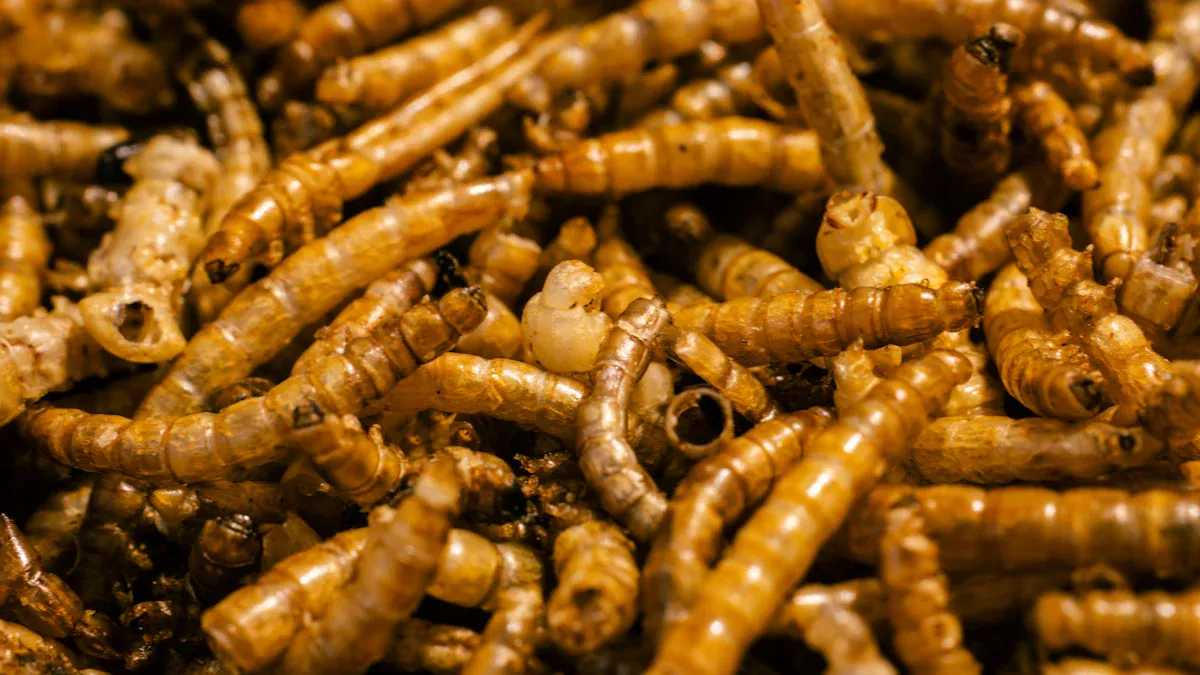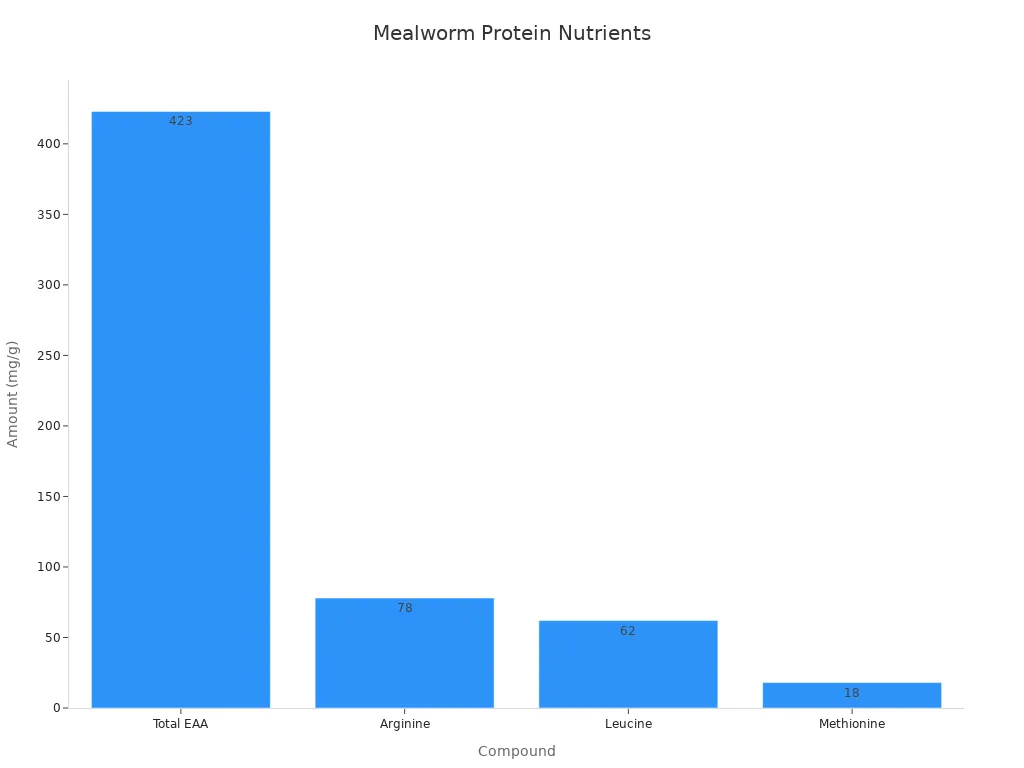
Have you ever wondered how you can boost livestock growth while saving costs? Mealworm protein might be the answer. Studies show replacing 10-15% of soybean meal with mealworms improves weight gain and feed efficiency in chickens. “Chubby Dried Mealworms” offer a high-quality, sustainable protein source that’s perfect for African farmers.
Key Takeaways
- Mealworm protein helps animals grow faster and eat more efficiently. It is a great option for farmers to increase production.
- Using mealworm protein can save small farmers money on feed. It is a cheaper option than regular feed types.
- Farming mealworms is better for the environment. It produces less pollution and uses fewer resources than normal livestock farming.
What Is Mealworm Protein?

Understanding Mealworm Protein
Mealworm protein comes from the larvae of the mealworm beetle, a small insect that’s packed with nutrients. These larvae are dried and processed into a protein-rich powder or meal. You might wonder why mealworms are gaining attention. Well, they’re not just easy to farm but also incredibly efficient at converting organic matter into protein. Compared to crickets, mealworms are easier to rear, have lower mortality rates, and are less prone to diseases. This makes them a reliable and sustainable option for livestock feed.
Mealworm farming also addresses sustainability concerns. For example, replacing fishmeal in aquaculture with mealworm protein reduces the strain on marine resources. However, current farming practices need to become more cost-effective to make mealworms a mainstream feed ingredient.
Nutritional Profile and Benefits
Mealworm protein is a nutritional powerhouse. It’s loaded with essential amino acids, healthy fats, and minerals. Here’s a quick breakdown of its nutritional profile:
| Component | Amount (mg/g) | Notes |
|---|---|---|
| Total EAA | 423 | Represents essential amino acids in cells |
| Arginine | 78 | Highest concentration among EAAs |
| Leucine | 62 | Second highest concentration |
| Methionine | 18 | Lowest concentration among EAAs |
| Total Amino Acids | 951 | Total amino acids in cells |
| Glutamic Acid | 219 | Highest among NEAAs |
| Tyrosine | 22 | Lowest among NEAAs |
| Minerals | K, Na, Mg, Ca | Higher in mealworms than wheat bran-fed |
Mealworm protein also benefits animal health. Research shows it improves metabolic health, slows weight gain, and enhances immune response. It even helps reduce bad cholesterol (LDL) while increasing good cholesterol (HDL).

Why “Chubby Dried Mealworms” Are a Game-Changer
If you’re looking for a high-quality protein source, “Chubby Dried Mealworms” stand out. They’re rich in protein, fats, and essential nutrients, making them perfect for livestock. Plus, they’re more efficient than traditional protein sources. Mealworms require less space, water, and feed, which means a smaller environmental footprint.
Switching to “Chubby Dried Mealworms” can also improve your livestock’s growth and health. They enhance energy metabolism, reduce inflammation, and boost immune response. With these benefits, it’s no wonder they’re becoming a favorite among African farmers.
Benefits of Mealworm Protein for African Livestock Producers
Boosting Livestock Growth and Productivity
Mealworm protein can work wonders for your livestock. It’s packed with essential nutrients that help animals grow faster and healthier. For poultry farmers, mealworms can improve feed efficiency and weight gain. Imagine your chickens reaching market size quicker while staying healthy. That’s a win-win for you and your business.
Farmers who’ve tried mealworm protein have seen promising results. Half of the poultry farmers surveyed accepted chicken products fed with mealworms. This shows that mealworm-fed livestock is not only productive but also marketable. With increased awareness, more farmers are likely to embrace this sustainable protein source.
Cost-Effectiveness for Small-Scale Farmers
If you’re a small-scale farmer, you know how important it is to keep costs low. Mealworm protein could be your secret weapon. Many farmers believe it can lower feed costs while boosting profits. In fact, 72% of farmers are willing to adopt mealworms as a protein source because of its economic benefits.
However, the current market price of mealworm meal isn’t yet as competitive as traditional feeds. But don’t let that discourage you. As production scales up and demand grows, prices are expected to drop. This makes mealworm protein a smart investment for the future.
Environmental Sustainability and Resource Efficiency
Mealworm protein isn’t just good for your wallet—it’s great for the planet too. Producing mealworms has a much smaller environmental footprint compared to traditional livestock systems. A study in Austria found that mealworm production reduces environmental impacts by 18–72% across various categories. This includes lower greenhouse gas emissions and less land and water use.
Switching to mealworm protein can help you contribute to a more sustainable future. Plus, products like Chubby Dried Mealworms make it easier than ever to adopt this eco-friendly feed option.
Challenges in Adopting Mealworm Protein
Scaling Up Mealworm Production
Scaling up mealworm production is no small feat. While mealworms are efficient to farm, producing them on a large scale requires significant planning and investment. Current projections show that by 2030, the mean production capacity could reach 293 tonnes annually, with harvested larvae numbers climbing to 5.2 trillion. These numbers are promising, but achieving them depends on overcoming logistical and financial hurdles.
One major challenge is the lack of a robust policy framework in many African countries. For example, South Africa doesn’t yet have clear regulations for using insects as animal feed. Without government support, scaling up production becomes even harder. Additionally, delays in regulatory approvals slow down the adoption of mealworm protein, making it difficult for producers to expand operations.
Addressing Initial Investment Barriers
Switching to mealworm protein can feel like a big leap, especially for small-scale farmers. The initial costs of setting up mealworm farming or purchasing mealworm-based feed can be daunting. Industry challenges, like the €130 million funding gap faced by companies such as Ÿnsect, highlight the broader financial struggles in this sector.
Regulatory hurdles also add to the cost. Approval processes for novel food products can take years, discouraging potential investors. Slow consumer adoption further complicates matters, as limited demand makes it harder for producers to justify the upfront expenses.
Educating Producers on the Benefits
Many farmers are still unaware of the benefits of mealworm protein. A study in South Africa found that most small-scale poultry farmers didn’t know mealworms could be used as feed. However, younger farmers and those with secondary education showed a strong willingness to adopt this alternative protein source.
To bridge this knowledge gap, targeted awareness programs are essential. Agricultural extension agents can play a key role in educating farmers, especially older ones, about the economic and environmental advantages of mealworm protein. With the right information, more producers can embrace this sustainable solution.
Success Stories from African Livestock Producers
Poultry Farmers Achieving Higher Yields
You might be surprised to learn how mealworm protein is transforming poultry farming in Africa. A study in South Africa revealed that younger farmers, aged 18-45, are particularly excited about using yellow mealworms as chicken feed. Nearly half of them showed interest in adopting this innovative protein source. What’s even more encouraging is that half of the surveyed poultry farmers accepted chicken products fed with mealworms.
This shift isn’t just about curiosity—it’s about results. Farmers who’ve incorporated mealworm protein into their feed have reported healthier chickens and faster growth rates. Imagine your chickens reaching market size quicker while maintaining excellent health. That’s the kind of impact mealworm protein can have on your farm.
Aquaculture Producers and Improved Growth Rates
If you’re in aquaculture, mealworm protein could be a game-changer for you too. Studies show that fish like African catfish thrive on diets with up to 17% mealworm protein. This level doesn’t just maintain growth—it matches the performance of traditional feeds. Fish fed with 25% mealworm protein even achieved comparable protein efficiency ratios (PER) to those on standard diets.
However, it’s important to find the right balance. Research indicates that exceeding 25% mealworm protein can reduce growth rates in some species. But when used correctly, mealworm protein can help you produce healthier, faster-growing fish. It’s a sustainable way to boost your aquaculture yields.
Lessons from Early Adopters of “Chubby Dried Mealworms”
Farmers who’ve tried “Chubby Dried Mealworms” are already seeing the benefits. These mealworms are packed with protein and essential nutrients, making them an excellent choice for livestock feed. Early adopters have reported improved energy levels and better immune responses in their animals.
One key lesson from these pioneers is the importance of starting small. Many began by replacing a portion of their traditional feed with mealworm protein. This approach allowed them to test the benefits without taking on too much risk. You can do the same—start with a small batch of “Chubby Dried Mealworms” and see the difference for yourself.
Mealworm protein offers incredible benefits for livestock farming. It improves yields, saves costs, and supports sustainability. Check out this quick summary:
| Benefit | Mealworm Protein Highlights |
|---|---|
| Nutrient Density | Packed with proteins, fats, vitamins, and minerals. |
| Lower Cost | Efficient and cost-effective at scale. |
| Versatility | Works across various livestock feed applications. |
While challenges exist, education and small-scale trials can help you get started. Why not try “Chubby Dried Mealworms” and see the difference for yourself? 🌱
FAQ
What makes mealworm protein better than traditional feed options?
Mealworm protein is nutrient-dense, eco-friendly, and versatile. It boosts livestock growth while reducing environmental impact. Plus, it’s a sustainable alternative to fishmeal or soybean meal. 🌱
Can I use mealworm protein for all types of livestock?
Yes! Mealworm protein works for poultry, fish, and even pigs. It’s a flexible feed option that supports growth and health across various livestock types.
Tip: Start small by replacing a portion of your current feed with mealworm protein. Monitor the results and adjust as needed!
Is mealworm protein safe for my animals?
Absolutely! Studies show mealworm protein is safe and nutritious. It enhances immune response, improves metabolism, and supports overall animal health.


